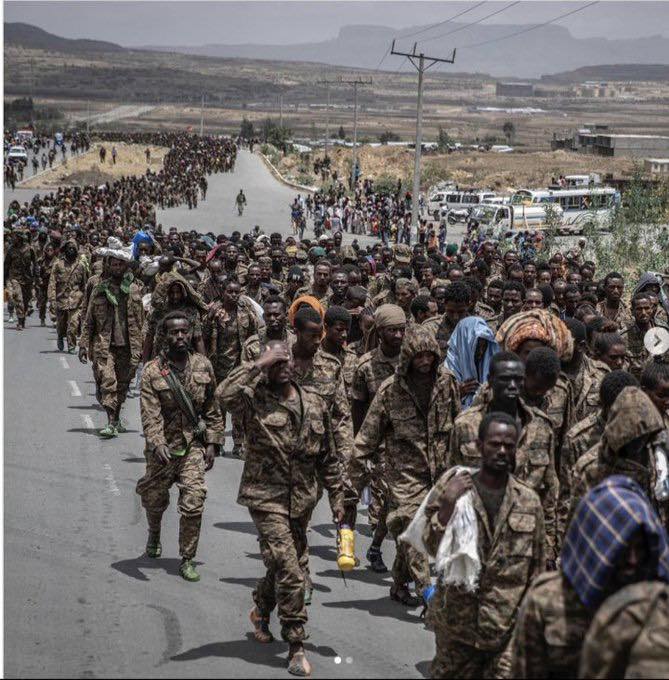
Ethiopia among African countries at epicenter of rising conflicts: Global Peace Index 2025
https://addisstandard.com/ethiopia-amon ... 025/?amp=1
June 20, 2025

The scar of war in the Tigray region on diplay in the main highway connecting the capital Mekelle with Weldiya in the Amhara region. Photo: Addis Standard
Addis Abeba – African countries continue to be one of the most conflict-ridden countries in the world, according to the Global Peace Index 2025, released by the Institute for Economics & Peace (IEP). The report identifies Ethiopia, Sudan, the Democratic Republic of the Congo (DRC), and South Sudan, among the world’s top conflict escalation hotspots, with each country experiencing severe violence, humanitarian crises, and political instability.
the 122 pages IEP report https://www.visionofhumanity.org/wp-con ... 25-web.pdf notes.There are currently 59 active state-based conflicts globally- the highest number since World War II – and Africa is home to some of the most dangerous of them,
Sudan ranks as the third least peaceful country in the world, behind only Ukraine and Russia. The country has suffered a devastating civil war https://addisstandard.com/news-more-tha ... lla/?amp=1 between the Sudanese Armed Forces (SAF) and the Rapid Support Forces (RSF) since April 2023. In 2024 alone, more than 6,800 conflict-related deaths were recorded, while the displacement of millions has created a dire humanitarian emergency.
_______________
Ethiopia/Eritrea is one of four conflict dyads with the highest risk of rapid and severe escalation in the near term
IEP
_______________
The DRC, meanwhile, saw its peacefulness deteriorate further, ranking 160th out of 163 countries.
the report states.The Democratic Republic of the Congo continues to experience sustained violence from dozens of armed groups, with one of the world’s worst records for conflict deaths and displaced populations,
Ethiopia remains in deep crisis. Despite the formal end of the two-year devastating war in the Tigray region, the report warns that tensions between Ethiopia and Eritrea https://addisstandard.com/lt-gen-tsadka ... war/?amp=1 continue to pose significant escalation risks.
Although the report did not focus on the ongoing conflicts in other regions of Ethiopia, the active militarized conflicts in the Amhara and Oromia regions continued caused untold sufferings to civilians and vital infrastructures in both regions.Ethiopia/Eritrea is one of four conflict dyads with the highest risk of rapid and severe escalation in the near term.
The near two-year conflict in the Amhara region involving government and various Fano armed groups has caused worsening humanitarian crises marked by mass killings, https://addisstandard.com/news-resident ... yle/?amp=1 displacement, https://addisstandard.com/amhara-region ... ict/?amp=1 food shortages, https://addisstandard.com/news-a-quarte ... ion/?amp=1 as well as the disruptions to essential services, https://addisstandard.com/drivers-in-am ... ces/?amp=1 including health and education. Similarly, the conflict in the Oromia region involving government forces and the Oromo Liberation Army (OLA) saw no end in sight as it entered its sixth years.
Talks that were held in Zanzibar and in Dar es Salaam in Zanzibar that were mediated by IGAD with support from Norway, Kenya, and the U.S. ended without agreement due to unresolved political issues, despite high-level participation https://addisstandard.com/endf-reports- ... lks/?amp=1 in Dar es Salaam from OLA leaders.
Furthermore, more than 11,000 people have been displaced in recent weeks due to armed violence https://addisstandard.com/over-11000-di ... ons/?amp=1 in the border areas of Oromia and Benishangul-Gumuz regions.
Militarization, external involvement, and escalation risks
IEP’s report highlights that Africa is not only experiencing internal conflict but is also increasingly entangled in external engagements. Cameroon, Nigeria, Rwanda, Ghana, and Niger are each involved in five or more external conflicts, mainly through peacekeeping or counterinsurgency operations
the report states.There are now 98 countries involved in some form of external conflict – up from 59 in 2008,
The Sahel region remains a flashpoint. The index notes that instability and resource scarcity have made the region a ground zero for geopolitical competition, with both state and non-state actors vying for influence and control. Terrorism, particularly in Mali, Burkina Faso, and Niger, has intensified.In most cases, countries are supporting governments against armed rebels or terrorist groups.
_______________
Peace inequality is deepening. The gap between the most and least peaceful countries has widened by 11.7% over the past two decades
IEP
_______________
The impact of these conflicts is not merely human – it’s economic. According to the report, violence cost the global economy $19.97 trillion in 2024, with developing nations in sub-Saharan Africa among the hardest hit.
it reveals.Military and internal security expenditure alone account for over 74% of this cost,
says the report.We are entering an age of global power fragmentation,
In a sobering assessment, the report underscores that the pathways out of Africa’s conflicts remain narrow. Fewer conflicts are ending in peace deals or decisive victories.Peace inequality is deepening. The gap between the most and least peaceful countries has widened by 11.7% over the past two decades.
the report explains.Only 4% of conflicts now end in peace agreements, compared to 23% in the 1970s,
Invest in peace
IEP stresses the importance of building “Positive Peace” – the institutions, attitudes, and structures that underpin a peaceful society. But in a troubling trend, global investment in peacebuilding has declined by 26% since 2008.
the report warns.Spending on peacebuilding and peacekeeping in 2024 amounted to just 0.52% of total military expenditure,
With warning signs flashing across the continent, the report calls for immediate and coordinated international efforts to reverse these dangerous trajectories. Without them, Africa’s escalating conflicts could soon spill beyond its borders – with global consequences. ASThe number of deployed peacekeepers has fallen by 42% over the past decade, even as conflicts rise.


